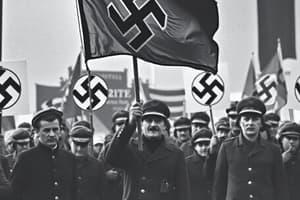Podcast
Questions and Answers
What did the Nazis aim to achieve by invading other countries?
What did the Nazis aim to achieve by invading other countries?
- To promote peace
- To gain economic stability
- To provide Lebensraum (living space) (correct)
- To create alliances
Which treaty did the Nazis seek to undo?
Which treaty did the Nazis seek to undo?
- Treaty of Versailles (correct)
- Treaty of Paris
- Treaty of Ghent
- Treaty of Rome
The Nazis aimed to eliminate Communism.
The Nazis aimed to eliminate Communism.
True (A)
What slogan did the Nazis use to resonate with people's desires?
What slogan did the Nazis use to resonate with people's desires?
Who was a famous public speaker associated with the Nazi party?
Who was a famous public speaker associated with the Nazi party?
What role did he become head of during the Nazis' rise to power?
What role did he become head of during the Nazis' rise to power?
Hindenburg made Hitler Chancellor.
Hindenburg made Hitler Chancellor.
What percentage of votes did the Nazis win in the election?
What percentage of votes did the Nazis win in the election?
Flashcards are hidden until you start studying
Study Notes
Nazi Objectives
- Lebensraum sought to expand German territory through invasion of other countries.
- Aimed to nullify the Treaty of Versailles, which Germany viewed as punitive.
- Planned to cease reparations payments imposed by the Treaty.
- Aspired to restore Germany's greatness through a strong, decisive government.
- Desired to eliminate Communism as part of their political agenda.
- Targeted the Jewish population, framing them as the cause of Germany's issues.
Nazi Promises and Appeal
- Utilized simple slogans like "Bread and Work" to connect with the populace.
- Promised jobs in public works programs, such as motorways, and military expansion due to rearmament.
- Hitler's charisma as a powerful public speaker amplified party support.
- Employed scapegoating, blaming Jews for economic troubles and societal decay.
- Promoted self-sufficiency in agriculture to benefit German farmers and reduce dependence on foreign goods.
Additional Political Motivations
- Sought to curtail Communism and prevent worker uprisings against employers.
- Strong nationalist sentiments aimed to restore Germany’s international standing.
Key Figures in Nazi Leadership
-
Hermann Göring:
- Celebrated as a German war hero from World War I, notably as a pilot.
- Held the position of head of the army.
- Temporarily led the Nazi Party during Hitler's imprisonment in 1924.
- Became head of the SA (Sturmabteilung).
-
Heinrich Himmler:
- Led the SS (Schutzstaffel), the Nazi Party's paramilitary organization.
- Oversaw the Gestapo, the secret police responsible for widespread fear and repression.
- Eventually took charge of the 'Final Solution', the plan for the genocide of Jews.
Political Landscape
- The Nazis secured 37% of votes in elections, showing significant popular support.
- President Hindenburg resisted appointing Hitler as Chancellor, instead choosing Von Papen for the role.
- Political instability in the Reichstag contributed to the turmoil and power struggles of the time.
Studying That Suits You
Use AI to generate personalized quizzes and flashcards to suit your learning preferences.




